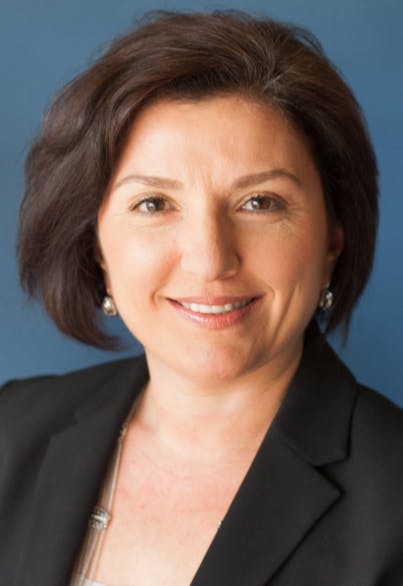Executive director of the new CalKIDS Institute at UCLA will help to ensure that all children – including those in foster care and the unhoused – can plan a bright future.
While a social worker in the L.A. County Department of Department of Children and Family Services, Nayiri Nahabedian realized there had to be a better way to address cases of child abuse and other conditions that prevent low-income children, particularly those in foster care from thriving and succeeding in school and in life.
Today, Nahabedian is poised to find that better way, as executive director of the CalKIDS Institute at UCLA. Established earlier this year with a $3 million grant from the state, the Institute will be tasked with providing UCLA expertise to evaluate and enhance the California Kids Investment and Development Savings program (CalKIDS), a statewide child savings program launched by Gov. Newsom in 2022. CalKIDS is overseen by ScholarShare 529, a statewide initiative that provides every child born in California with a savings account and a seed deposit. The CalKIDS Institute will work with research, examining policy, and promoting socio-economic justice by ensuring that all individuals, groups, and communities have the tools necessary to achieve financial capability and well-being.

UCLA alumna Nayiri Nahabedian (’91, B.A., Psychology; ’95, MSW) serves as executive director of the CalKIDS Institute.
Nahabedian underscores the potential of saving early for college, and acknowledges that, “…In this country, the income gap between those who have less and those who have a lot is huge. But what is even larger is the asset gap – there are families who have nothing in terms of assets or are in a minus. Children’s savings accounts [provide] the opportunity to have more equity.
“In addition to these concrete financial assets, there are a lot of social and emotional benefits,” she says. “When children know they have a savings account, it can positively impact social and emotional well-being, as well as parents’ expectations of their educational outcomes, which [is] related to how well children do in school. It’s also been demonstrated that it increases college attendance and college completion.”
Nahabedian leads by example and has established 529 accounts for her nieces.
“Every so often I get something in the mail with their names on it,” she says. “They get a look at it and see it grow. The main thing is they’re thinking about [college]. And it becomes a wonderful real-life example when financial literacy or math comes up in school [around] compound interest, addition, subtraction, debt, or savings.”
One aim of the CalKIDS Institute is to learn how statewide children’s savings accounts impact their holders and their families. Nahabedian recalls how as a graduate student at UCLA, she was struck by the idea of this long-term intervention for children and families who may not have even considered college, let alone setting funds aside to attend.
“The story starts in Dodd Hall, where I was a graduate student in social welfare,” says Nahabedian. “I was taking a child welfare policy and services class and Dr. Duncan Lindsey had just published his book, ‘The Welfare of Children.’ He made the case that case management alone was limited in its ability to fully protect kids and families. Our assessments told us that over 90 percent of families that came to the attention of DCFS were poor families. His concluding chapter was about children’s savings accounts, where every child born gets an account for [themselves] at a national level, and then, every year, there would be additional dollars invested in that account.
“The values of UCLA Ed&IS, related to social justice and equity parallel the values and mission of an intervention like a children’s savings account,” says Nahabedian. “I took with me the value that social work must come back to the fact that money matters to families and that financial wellbeing and financial inclusion are things we need to attend to if we are committed to justice and equity.”
Nahabedian underscores the fact that the CalKIDS program is intended to help all of California’s families – including the middle class – to save for their children’s education.
“What is important is that it’s for all newborns – it’s not means-tested,” she says. “Even middle-class kids don’t often have the opportunity to have assets. Just like Social Security for older adults, the middle class is also benefitting from it, because it’s important for all kids. CalKIDS is also progressive in its approach. School-aged kids who have less get a higher level of benefit – a higher level of seed deposit in their accounts.”
Serving on the Glendale Board of Education has given Nahabedian a unique perspective on programs such as CalKIDS.
“I am more of a macro-social worker, meaning I am interested in working with policies and structures and changing environments that impact individuals and families,” she says. “An intervention can be implemented to make things better. But what I also know is that the implementation phase can be tricky. You can have an intervention or a policy, but the way it’s implemented on the ground can make or break a wonderful idea.
“I would tell my students, when I was teaching in the School of Social Work at Cal State LA, the words that we use, and the way that we use them, are our tools. They’re [preparing] to be social workers, working with clients, so it matters a great deal. With child savings accounts, we’re still finding out what are the words and the way to use words to engage families and meet them where they’re at, [to] benefit from this intervention.”
During the COVID-19 pandemic, Governor Newsom added more federal funding to CalKIDS, including all first-graders who qualified for reduced lunch, were in foster care, or were unhoused. All newborns, regardless of financial status, have accounts starting with $100, up to $175. For school-aged children, new CalKIDS accounts are based on eligibility. Students who are low-income and qualify for free and reduced lunch receive $500, and can receive an additional $500 if they are in foster care, and another $500 if unhoused. Governor Newsom funded grades 1-12 in the 2021-2022 school year, plus all subsequent first-graders. High school graduates of 2022 can now access these funds and use them.
Nahabedian extols the benefits of CalKIDS beyond the financial resources, and says that through the program, extended family members and local communities have not only the ability to contribute but to send the message that they are invested in the education and futures of their youth.
“Families can also open their own parallel family account, which they can see next to [the CalKIDS] account on the screen,” says Nahabedian. “The family can save in that account – grandparents, aunts, uncles, relatives can add to it. School districts can do campaigns [like] ‘Deposit Day’ to encourage [saving]. Children understand that this savings account is something that not only their family cares about, but that others in their community care about. Kids need to know that the adults around them are invested in them [and] that they know they’re going to be successful.”
Nahabedian says that among the goals of the CalKIDS Institute are studying ways to further engage families in knowledge of the 529 accounts, best practices for getting them involved in planning for their children’s education, and making sure that CalKIDS is being used to its best advantage, including providing funds for students who seek career and technical training.
“There’s a gap between what we know we want to do and what we actually end up doing,” says Nahabedian. “People want to exercise more, eat healthier, or stop a habit, and it’s not easy to create those shifts as human beings, even in the best of circumstances. So, to ask families to be involved in their financial wellness while they have so much going on, it’s really incumbent upon us to consider how to meet them where they’re at and to evaluate and assess what would be most helpful to them.
“At the end of the day, we want to support children and families,” she says. “Finances matter in higher education. But hope matters, and opportunity matters. When kids know there is a commitment by the adults around them to give them opportunities, that creates shifts in the way that they think about their ability to succeed. You can create policies to impact communities and families. But building a higher education culture makes every kid feel like they have an opportunity, that, ‘We are invested in all of you, not just some of you.'”
A double Bruin (’91, B.A., Psychology; ’95, MSW), Nahabedian has served on the Glendale Unified Board of Education since 2007 and is its immediate past president. As such, she has been an advocate for inclusion and equity for all children and has been instrumental in growing the district’s dual language immersion programs, expanding mental health services, reducing rates of expulsions and suspensions, and spotlighting the importance of financial literacy.
In 2018, Nahabedian led efforts to launch the Glendale Unified College Success Fund, which provides a college savings account for every 1st grade student in the district. She also served as chief advisor on financial capacity and asset building to California Assemblymember Adrin Nazarian, who was the main author of CalKIDS.
Before arriving at UCLA, Nahabedian was a faculty member of the School of Social Work at California State University, Los Angeles. She has been honored with numerous awards, including the Alas – Wings Award, ¡Adelante, Latinos! (2020); the CSULA Margarita Mendez Award (2020); and the Robert F. Kennedy Leadership Award from the San Fernando Young Democrats (2017). Under Nahabedian’s leadership, the GUSD Board of Education was recognized as Organization of the Year by the Crescenta Valley Chamber of Commerce (2020).
